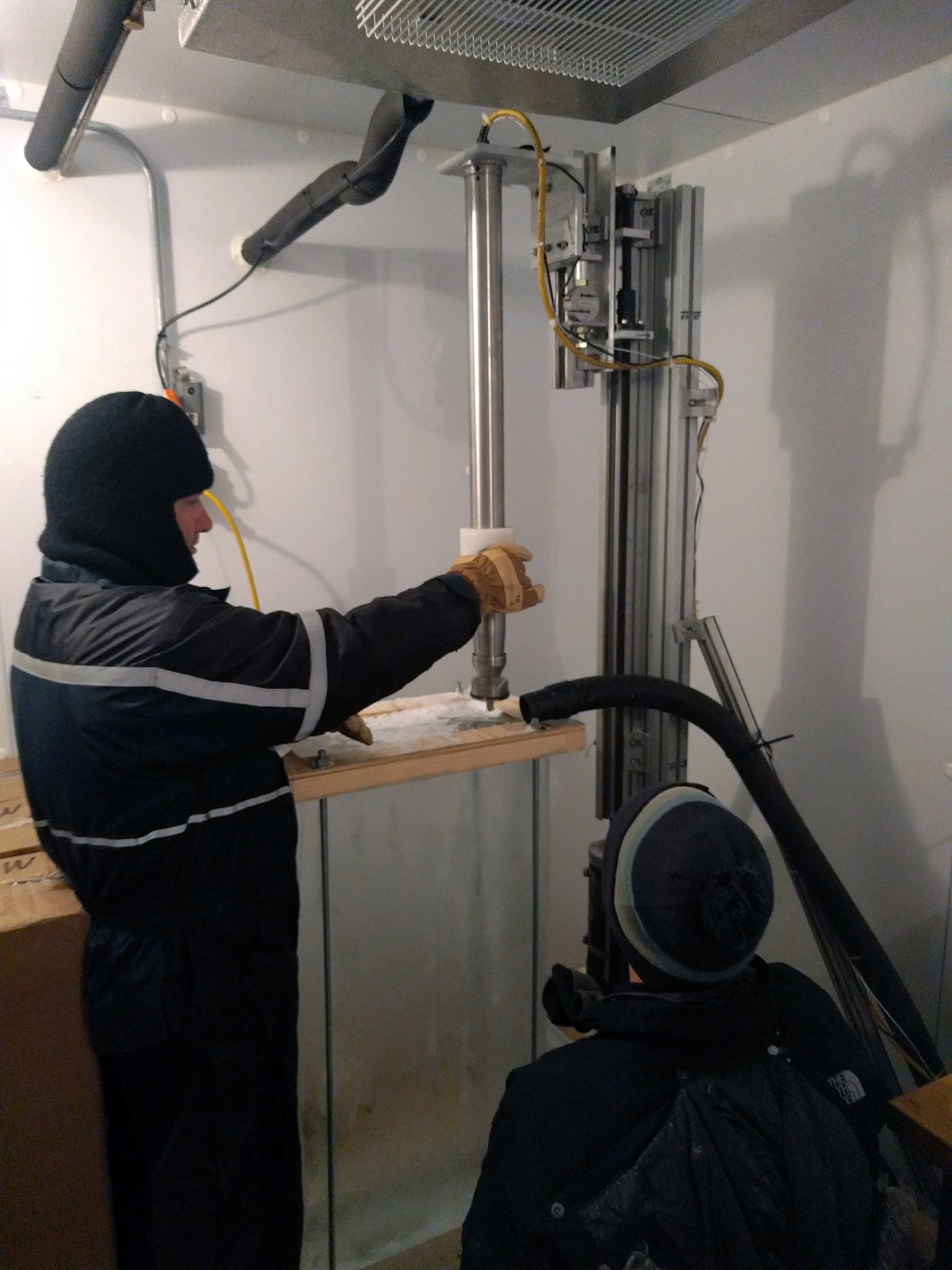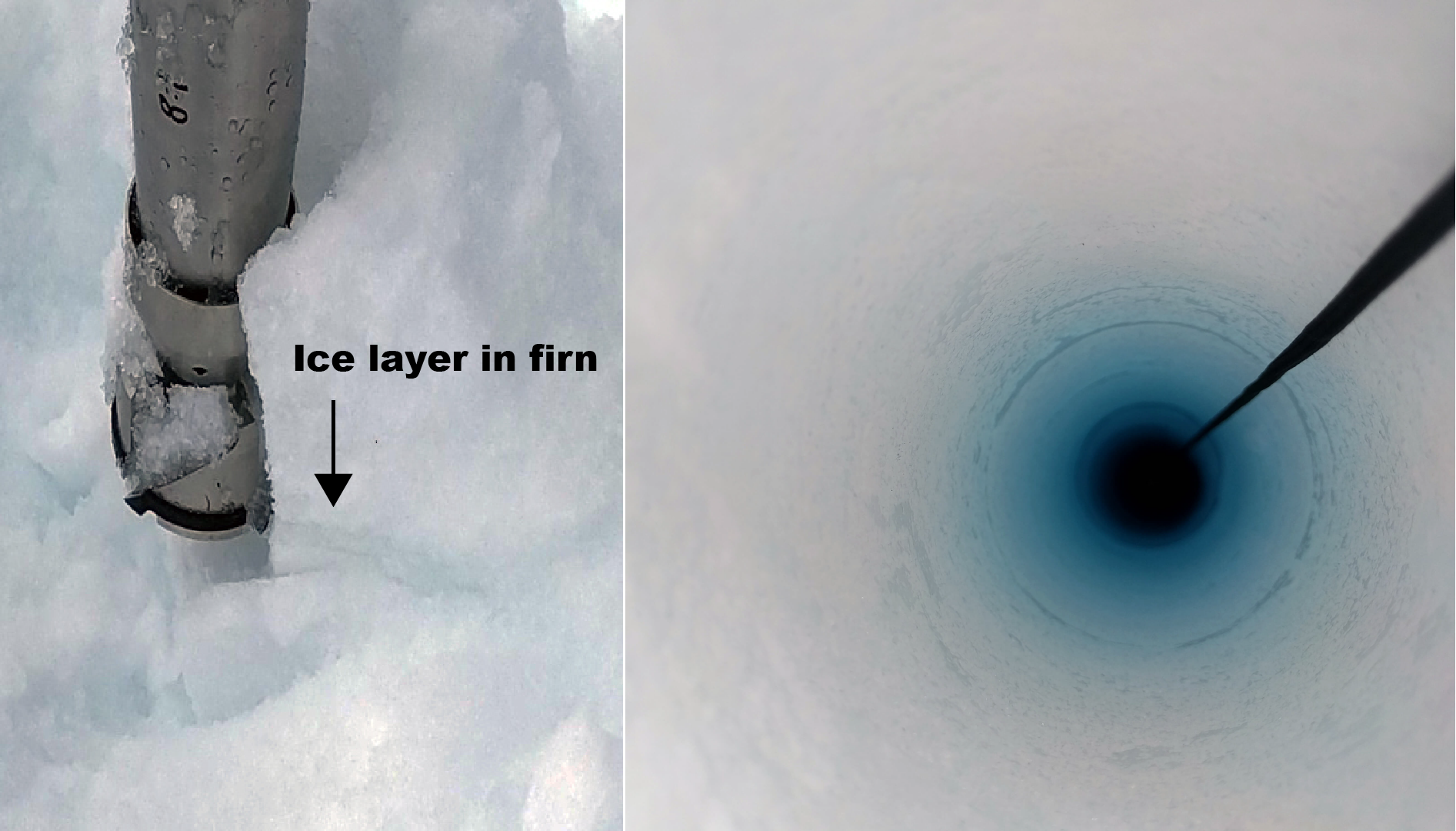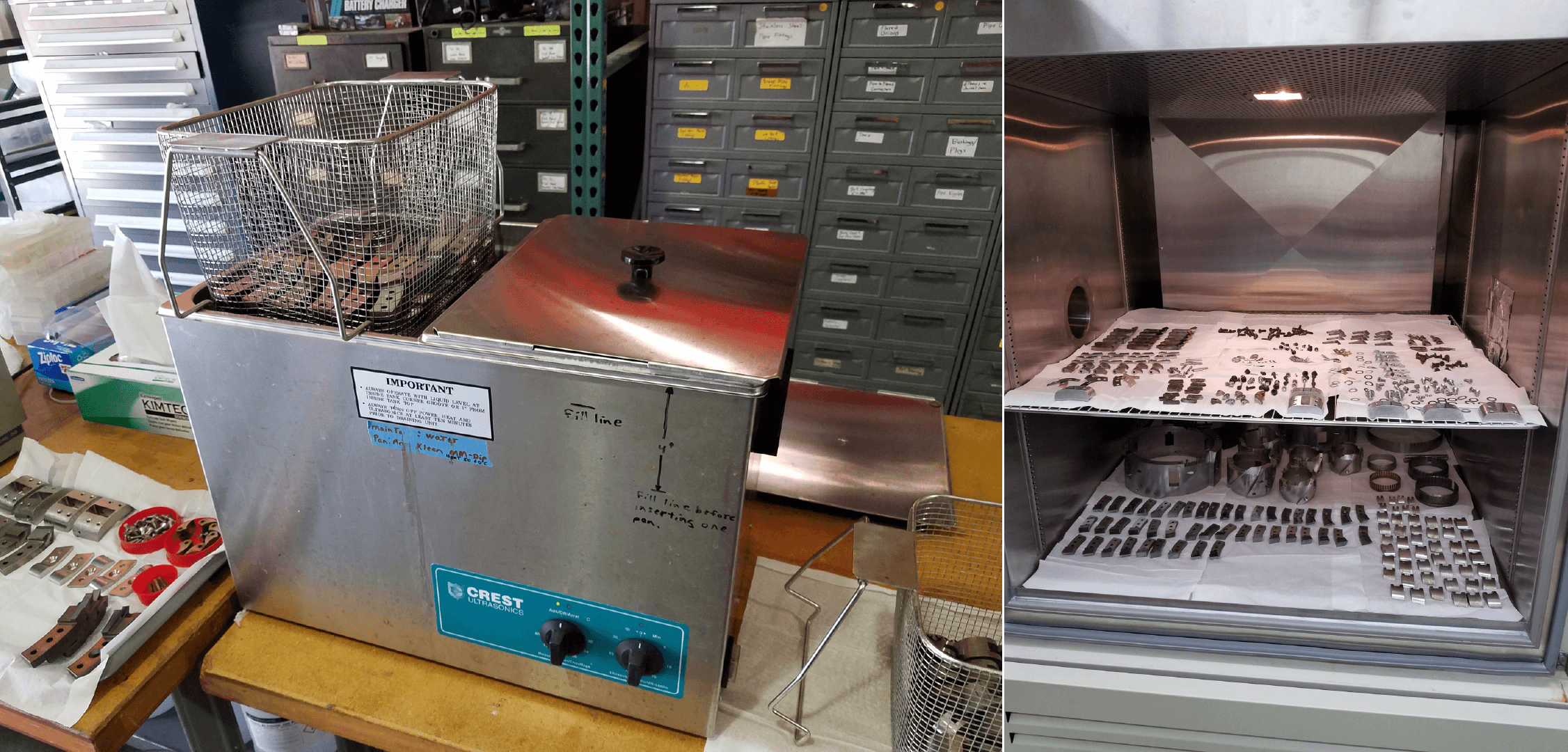Rapid Air Movement (RAM) Drill Test Completed at Raven Camp in Greenland
- Rapid Air Movement (RAM) Drill
Throughout the third quarter, IDDO engineers worked hard to ready the upgraded Rapid Air Movement (RAM) Drill system for a field test in Greenland. In late July, IDDO engineers Chris Gibson and Tanner Kuhl traveled to Raven Camp in Greenland and conducted a full-scale system test of the new equipment. The new RAM Drill, known as RAM 2, is slated for use on Thwaites Glacier beginning in the 2019-2020 Antarctic season (PI Anandakrishnan). During the test, 26 drill runs resulting in 17 boreholes were completed, with a max hole depth of 28m. The site's altitude at 6,900 ft. played a role in limiting the depth, though the equipment ran very well. While altitude and very warm temperatures at Raven Camp hampered the team's ability to reach the desired depth goal of 55 m, IDDO engineers are confident that they can make modifications to the system to help it reach its peak performance. The equipment is expected to return to Madison, WI in early September, after which the IDDO team will have three weeks to implement any modifications or repairs before shipping the drill south, a year in advance of the fieldwork in West Antarctica.
Antarctic Cargo Preparation Commences for Law Dome Project
- 4-Inch Drill
- Eclipse Drill
- Blue Ice Drill (BID)
- Fieldwork
In early June, IDDO turned its attention to cargo preparation for the Law Dome field project (PI Petrenko). IDDO staff have been participating in regular teleconferences with the science team and the Australian Antarctic Division to prepare for the joint U.S.-Australian supported fieldwork. At IDDO, an extensive cleaning protocol was implemented for a 4-Inch Drill, a Badger-Eclipse Drill and the Blue Ice Drill, to ensure carbon-free sampling during the upcoming Law Dome project. Drill parts underwent ultrasonic cleaning in acetone, followed by further cleaning in ethanol and deionized water. Metal parts such as coring heads, cutters, etc. were further baked overnight in an environmental chamber. The cargo was subsequently shipped on July 26, 2018, to Port Hueneme, CA, eventually bound for Hobart, Tasmania.
Equipment Updates (2018 Summer)
- Foro 3000 Drill
- Foro 400 Drill
- Rapid Air Movement (RAM) Drill
- Intermediate Depth Drill (IDD)
- Winkie Drill
- Blue Ice Drill (BID)
- Thermal Drill
- Hand Auger
- 4-Inch Drill
- Eclipse Drill
Foro 3000 Drill
IDDO continued initial development tasks for the Foro 3000 Drill system during the third quarter. Detailed design of the winch drum and level wind are in process. Sizing calculations were made and a design initiated for the chip melter system. Sonde assembly drawings were largely completed. Design work is expected to ramp up in the fourth quarter in preparation for a Detailed Design Review in late September.
Foro Drill
Anti-torque section assembly was largely completed and motor section assembly was initiated on the Foro Drill. Cabling was completed for the control box and drill motors were ordered. Shipping cases were received for the sonde, tower, and winch. Cutter head assemblies, spare cable terminations, and anti-torque slip rings were also received. Some assembly and testing have been delayed in light of work on higher priority projects, but procurements are largely complete.
Rapid Air Movement (RAM) Drill
Continued acceleration of RAM Drill design, procurement, and in-house testing. The system was prepared, packed and shipped to Scotia, NY in late June. In early July, IDDO received an Expedition Permit from the Government of Greenland, and a two-week field test was subsequently completed at Camp Raven in late July.
Intermediate Depth Drill
Models and drawings were completed for the winch cable terminations and spare cable termination kits were received for the Intermediate Depth Drill. System maintenance continues at a slow pace, as does the testing and troubleshooting of the Mage Controls components. The components, returned to Mage Controls at the end of the second quarter, are expected back at IDDO early in the fourth quarter.
Winkie Drill
Borehole casing was specified and purchased in preparation for the Winkie Drill's first use in West Antarctica at a drill site with overlying firn. IDDO sought information from international colleagues regarding methods to seal the bottom of the casing to the ice. Packer components, benchtop testing for compressed air inflation, and detailed models of packer components were also researched.
Blue Ice Drill (BID)
Maintenance and upgrade tasks were largely completed during the quarter for the BID-1. The drill was subsequently cleaned, packed and shipped for the upcoming Law Dome project in Antarctica. IDDO continued communication with BID tent vendor Fabricon. Engineer Tanner Kuhl visited the vendor's location in mid-July to review the design and progress thus far, and the tent was completed in mid-August.
Thermal Drill
The Engineering Requirements document for the Thermal Drill was approved and released. IDDO engineers worked to identify, procure and test some thermal and power limiting materials and components during the quarter. New heat rings were specified, as the old model is now out of production, and a number of new rings were ordered late in the quarter.
Hand Augers
Planned modifications for the cleat and locking break components of the SideWinder units were implemented on all five kits in inventory. Equipment was returned from Svalbard and Greenland and was repaired as needed. Orders were subsequently placed for replacement of a few components that were stuck in the ice during the 2018 Arctic fieldwork.
4-Inch Drills
Maintenance was completed for the 4-Inch Drill system that returned from Antarctica. One core barrel set was modified to match beneficial modifications made to another barrel set in inventory. An improved cable keeper for the crown sheave was designed, fabricated and implemented.
Eclipse Drills
A more robust top cover and new side panels were installed on the Eclipse Drill traversing system. Beneficial updates were made to the Operator's Manual. Small tools such as strap wrenches and sharpening stones were purchased for use in the field.
2018 School of Ice
- Education/ Outreach
The School of Ice (SOI) convened on the campus at Dartmouth College July 29-August 1, 2018, with eleven participants attending from coast to coast including California, Florida, Hawaii, Minnesota, New York, Texas, and Washington. A dozen U.S. scientists presented their most recent research, and Louise Huffman (IDPO Director of Education and Public Outreach) organized 15 labs and inquiry activities for transferring ice core science to the participants' students. The evaluation is in the process of being quantified, but the verbal feedback was enthusiastic and positive with the SOI participants in agreement that they want IDPO to create ways in which they can stay in touch including webinars, email lists, and the SOI website. IDPO will establish longitudinal virtual communications, sharing and events with current and past SOI participants.
IDPO Education and Outreach at POLAR2018
- Education/ Outreach
In June, Louise Huffman was active in the POLAR2018 meeting in Davos, Switzerland. She convened 4 education outreach (EO) sessions marking a milestone in EO sessions at science meetings where at least half of the presenters were researchers and the orals were extremely well attended, numbering between 60-90 participants for each session. This is an indication that IDPO is making headway on bridging the gap between science and education.
In addition, at the POLAR2018 conference, Louise Huffman was an invited speaker on the International Polar Year (IPY) Mini- Symposium Panel, led a workshop for polar educators, served as a mentor during an Association of Polar Early Career Scientists (APECS) event, met with International Arctic Science Committee (IASC) and Scientific Committee on Antarctic Research (SCAR) leadership concerning a legacy project for POLAR2018.
2018-2028 Long Range Science and Long Range Drilling Technology Plans Updated
- Long Range Plans
- Science Advisory Board
The IDPO Science Advisory Board (IDPO-SAB), the IDPO-SAB working groups (Ice Core Working Group, Subglacial Access Working Group, and the Borehole Logging Working Group), and other community scientists, under Mary Albert's leadership, updated the IDPO Long Range Science Plan. The purpose of the Long Range Science Plan is to articulate goals and make recommendations for the direction for U.S. ice coring and drilling science, and for the development of drilling technology, infrastructure and logistical support needed to enable the science. The companion Long Range Drilling Technology Plan, updated by IDDO, identifies the drills and technologies needed to successfully implement the science in the Long Range Science Plan. Both plans are revisited and revised as appropriate each spring and are available at https://icedrill.org/scientists/scientists.shtml#scienceplan.
If you will need an ice core or a hole drilled in a glacier or ice sheet in the coming decade, or a rock core from under shallow glacial ice, please make sure that the high-level articulation of your science is captured in the IDPO Long Range Science Plan. If it isn't, send corrections, updates, or additions to IceDrill@Dartmouth.edu.
Ice Drilling Support for NSF Polar Proposals
- Funding Opportunities/ Solicitations
- Education/ Outreach
If you are preparing a National Science Foundation (NSF) proposal that includes any kind of support from IDP, you must include a Letter of Support from IDP in the proposal.
Researchers are asked to provide IDP with a detailed support request three weeks prior to the date the Letter of Support is required. Early submissions are strongly encouraged.
Scientists who seek to include IDP education and outreach activities associated with U.S. ice coring or drilling science projects should contact Louise Huffman at Louise.T.Huffman@Dartmouth.edu during their proposal preparation stage.
For further information on requesting IDP support, visit our website at https://icedrill.org/requesting-field-support or contact us at IceDrill@Dartmouth.edu.






